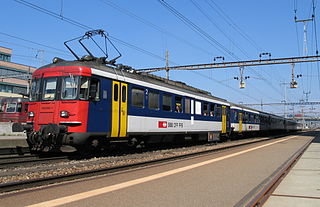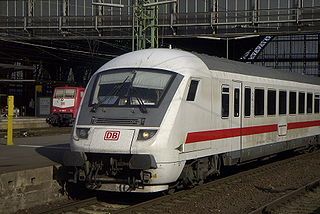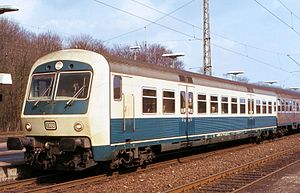
The Intercity Express is a system of high-speed trains predominantly running in Germany. It also serves some destinations in Austria, Denmark, France, Belgium, Switzerland and the Netherlands, mostly as part of cross border services. It is the highest service category of rail and the flagship train of the German state railway, Deutsche Bahn. There are currently 259 trainsets in use. ICE trains are the highest category trains in the fare system of the Deutsche Bahn. Their fares are not calculated on a fixed per-kilometre table as with other trains, but instead have fixed prices for station-to-station connections, levied on the grounds that the ICE trains have a higher level of comfort. Travelling at speeds up to 320 km/h (200 mph), they are tailored for business travellers or long-distance commuters and are marketed by Deutsche Bahn as an alternative to flights.

The British Rail Mark 3 is a type of passenger carriage developed in response to growing competition from airlines and the car in the 1970s. A variant of the Mark 3 became the rolling stock for the High Speed Train (HST).

The Baureihe 103 is a class of electric locomotives in Germany, originally operated by Deutsche Bundesbahn. For a long period, they were perceived as flagships of the DB rolling stock.

The Alstom Coradia LINT is an articulated railcar manufactured by Alstom since 1999, offered in diesel and hydrogen fuel models. The acronym LINT is short for the German "leichter innovativer Nahverkehrstriebwagen". It was designed by Linke-Hofmann-Busch and has been distributed as part of Alstom's Coradia family.

The Rhine-Ruhr S-Bahn is a polycentric and electrically driven S-train network covering the Rhine-Ruhr Metropolitan Region in the German federated state of North Rhine-Westphalia. This includes most of the Ruhr, the Berg cities of Wuppertal and Solingen and parts of the Rhineland. The easternmost city within the S-Bahn Rhine-Ruhr network is Unna, the westernmost city served is Mönchengladbach.

Starting in 1959, the SBB motor coach of the type RBe 4/4 was for a replacement of the old SBB electric locomotives Ae 3/6 I, Ae 3/6 II, Ae 3/6 III and SBB Ae 3/5 with three driving axles. As a consequence, they had much power at their disposal, even more than the Re 4/4 I locomotives, a regenerative brake, cabs on both ends with doors to passenger carriages as well as Multiple-unit train control SBB Vst IIId for multiple-unit or driving trailer. They originally motor coach had 64 seats, 32 smoking and 32 non-smoking, and were painted in ordinary SBB green.

A control car, cab car, control trailer, or driving trailer is a non-powered rail vehicle from which a train can be operated. As dedicated vehicles or regular passenger cars, they have one or two driver compartments with all the controls and gauges required to remotely operate the locomotive, including exterior locomotive equipment such as horns, bells, ploughs, and lights. They also have communications and safety systems such as GSM-R or European Train Control System (ETCS). Control cars enable push-pull operation when located on the end of a train opposite its locomotive by allowing the train to reverse direction at a terminus without moving the locomotive or turning the train around.

The Rhine-Main S-Bahn system is an integrated rapid transit and commuter train system for the Frankfurt/Rhine-Main region, which includes the cities Frankfurt am Main, Wiesbaden, Mainz, Offenbach am Main, Hanau and Darmstadt. The network comprises nine S-Bahn lines, eight of which currently travel through the cornerstone of the system, a tunnel through central Frankfurt. The first section of this tunnel was opened on May 28, 1978. Further tunnel sections were opened in 1983 and 1990, before its completion in 1992. The system belongs to the Rhein-Main-Verkehrsverbund (RMV) and is operated by DB Regio, a subsidiary of Deutsche Bahn.

The DB Class 403 was a series of three electric multiple units commissioned by the Deutsche Bundesbahn in the 1970s, an early predecessor of the Intercity-Express as a high-speed train. The units were mainly used for InterCity services and again by the Lufthansa airline in the 1980s. Due to the distinctive design of its front section, the unit was nicknamed the "Donald Duck". They were designed for operational speeds of up to 220 km/h, a speed which was also attained in extensive test drives, but they were limited to 200 km/h in regular DB service.

Wiesbaden Hauptbahnhof is a railway station for the city of Wiesbaden, the state capital of the German state of Hesse. It is a terminal station at the southern edge of the city centre and is used by more than 40,000 travelers each day, so it is the second largest station in Hesse after Frankfurt Hauptbahnhof. It is classified by Deutsche Bahn as a category 2 station.

Railjet is a high-speed rail service in Europe operated by Austrian Federal Railways (ÖBB) and Czech Railways (ČD). Branded as Railjet Express (RJX) for the fastest services and as Railjet (RJ) for services with additional stops, it was introduced in 2008 and operates at speeds of up to 230 km/h (143 mph). Railjet is ÖBB's premier service and operates both domestically within Austria and on international services to adjacent major cities in the Czech Republic, Germany, Switzerland, Italy, Hungary and Slovakia.

The DRG Class ET 85 was a German electric motor coach with the Deutsche Reichsbahn and, later, the Deutsche Bundesbahn.

The Uerdingen railbus is the common term for the multiple units which were developed by the German firm of Waggonfabrik Uerdingen for the Deutsche Bundesbahn and private railways after the Second World War. These vehicles were diesel-powered, twin-axle railbuses of light construction. The diesel motors were built into the chassis underneath the vehicle. The VT 95 and VT 98 of the former Deutsche Bundesbahn in particular, are associated with this concept. These vehicles were employed in passenger train duties on branch lines where steam or diesel train operations were less profitable. Including the units built under licence, a total of 1,492 power cars were built from 1950 to 1971; and the total number of units, including trailer and driving cars, was 3,306.

The DB Class 218 are a class of 4-axle, diesel-hydraulic locomotives acquired by the Deutsche Bundesbahn for use on main and secondary lines for both passenger and freight trains.

The accumulator cars of Class ETA 150 were German railbuses used extensively by Deutsche Bundesbahn (DB) for 40 years. The railcars were very comfortable to travel in because they were quiet, rode well on the rails owing to the weight of the batteries, and were pollution-free. They ran on both main and branch lines.

The DB Class 628 is a twin-car, diesel multiple unit operated by the Deutsche Bahn for local passenger rail services.

The Class V 80 is a type of German diesel-hydraulic locomotive operated by the Deutsche Bundesbahn, that was redesignated as Class 280 from 1968. It was the first, main line, diesel locomotive with hydraulic power transmission.

The Umbau-Wagen or Umbauwagen was a type of German railway passenger coach operated by the Deutsche Bundesbahn (DB) which appeared in the mid-1950s. The name means "rebuild coach" and they were made by rebuilding or converting former state railway (Länderbahn) compartment coaches, many of which were over 30 years old.

Intercity is the second-highest train classification in Germany, after the ICE. Intercity services are loco-hauled express train services, usually over long-distances. There are Intercity routes throughout Germany, and routes generally operate with a two-hour frequency, with multiple routes giving a more frequent service on core routes. Intercity services are operated by the DB Fernverkehr sector of Deutsche Bahn.

Frankfurt-Niederrad station is a station in the district of Niederrad in the southwest of Frankfurt am Main in the German state of Hesse.























